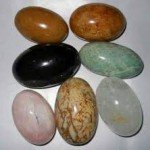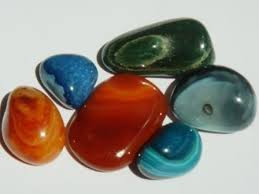Agate Stone Export
What Is Agate Stone?
ABOUT AGATE STONE
A generally accepted requirement in the definition of Agate is that it has to be banded. This qualification distinguishes it from other forms of Chalcedony which are not banded. Exceptions include Dendritic Agate an d Moss Agate, which are not true Agates since they lack the banding patterns, but they are still traditionally called Agates since they have more than one color. Onyx, when banded white and black, is technically a form of Agate, and Sardonyx, which is a banded reddish and white Chalcedony, is also technically a type of Agate. Some forms of Carnelian may also exhibit banding and can therefore be classified as both Carnelian and Agate.
d Moss Agate, which are not true Agates since they lack the banding patterns, but they are still traditionally called Agates since they have more than one color. Onyx, when banded white and black, is technically a form of Agate, and Sardonyx, which is a banded reddish and white Chalcedony, is also technically a type of Agate. Some forms of Carnelian may also exhibit banding and can therefore be classified as both Carnelian and Agate.
Deposits where Agates are commercially mined are usually very extensive, thereby enabling this gemstone to be affordable and inexpensive. However, a fine and sharp banded pattern, combined with natural strong coloring, will quickly increase the cost and value of and Agate. Specific Agate localities will provide similarities in banding style and color, thereby lending many Agates a geographic prefix. Other variety names used will connote specific colors or patterns, such as Fire Agate or Eye Agate.
The history of Ag ate production is closely tied to German town of Idar-Oberstein, which has evolved as an important gemstone center. Agates and Jasper were historically found in the Idar-Oberstein region, and cut and polished by local craftsman. With the discovery of the enormous Agate deposits in Rio Grande do Sul, Brazil in the 1800’s, the new material was shipped to Idar-Oberstein for cutting and polishing. The local Agate cutters of Idar-Oberstein were well-suited for this job, having been historically trained in this profession. Idar-Oberstain remains today as an important cutting and polishing center.
ate production is closely tied to German town of Idar-Oberstein, which has evolved as an important gemstone center. Agates and Jasper were historically found in the Idar-Oberstein region, and cut and polished by local craftsman. With the discovery of the enormous Agate deposits in Rio Grande do Sul, Brazil in the 1800’s, the new material was shipped to Idar-Oberstein for cutting and polishing. The local Agate cutters of Idar-Oberstein were well-suited for this job, having been historically trained in this profession. Idar-Oberstain remains today as an important cutting and polishing center.
USES
Agate is generally an inexpensive gemstone when used in jewelry. It is cut and polished into cabochons, and used as beads for necklaces and bracelets. It is also carved into cameos which can be worn as pendants. Agate makes an exquisite ornamental stone, and is cut into slabs, animal carvings, ornate book ends, and small statues and figures. Ornaments such as knife handles, pins, snuff boxes and the like are also cut from Agate.
VARIETIES
Agate has an over-abundance of variety names. Some variety names are generally used by collectors and dealers, but there are many made up by dealers to describe a locality or other habit. The varieties below are the well-known names or varieties that are commonly encountered. Seldom-used and localized trade names are not described here.
- Agate Geode – Layer of Agate surrounding a cavity in a geode that is usually lined with a layer of small Quartz crystals.
- Blue Lace Agate – Agate with light blue bands in a lacy or wavy pattern.
- Botswana Agate – Agate from the African country of Botswana banded with fine parallel lines of white, purple, or peach.
- Condor Agate – Agate from San Rafael, Argentina, often with vivid colors.
- Crazy Lace Agate – Agate with twisting and turning bands of various colors.
- Dendritic Agate – Translucent Chalcedony with tree-like or fern-like inclusions. Dendritic Agate is technically not a true Agate, as it lacks the banding patterns exhibited in Agates.
- Eye Agate – Agate with banded, concentric rings that are perfectly rounded.

- Fire Agate – Form of Agate or Chalcedony that is iridescent with a play of colors or “fire” similar to that of Opal. Fire Agates usually have botryoidal growth included in their interior. The play of color is caused by inclusions of Goethite or Limonite.
- Fortification Agate – Agate with a pattern in which all bands connect to each other, causing it to resemble a medieval fortress (i.e. imaginary moat and walls surrounding the castle).
- Iris Agate – Rare iridescent Agate that exhibits spectral colors on a translucent colorless or white base.
- Laguna Agate – Well known form of colorful Agate with very dense banding from Ojo Laguna, Chihuahua, Mexico.
- Moss Agate – Chalcedony containing dense inclusions of green Hornblende that cause the pattern to resemble moss. Moss Agate is technically not a true Agate as it lacks the banding patterns of Agate.
- Onyx – Type of Chalcedony gemstone whose meaning can have several connotations. Its most practical gemstone definition describes a solid black Chalcedony, or a banded or layered black and white Chalcedony.
- Sagenite Agate – Agate with acicular or or pointed inclusions of various minerals. These hair like formations are often arranged in fans or bursts.
- Sardonyx – Form of Agate with parallel bands of brownish to red alternating with white or sometimes black bands.
- Snakeskin Agate – Agate with a scale-like layer that resembles the skin of a snake. Also refers to a reddish brown Agate with small black concentric bands.
AGATE PHOTOS





